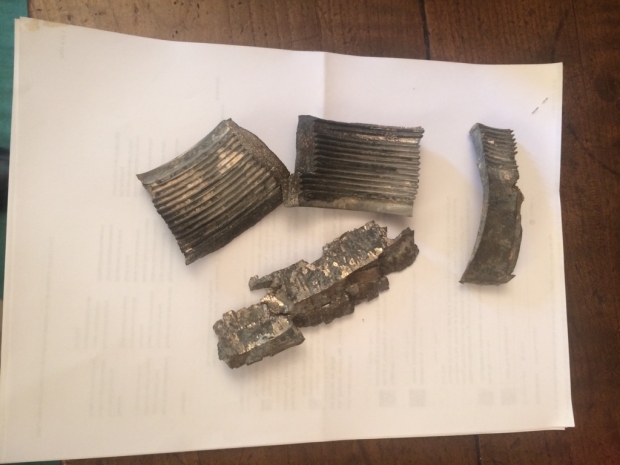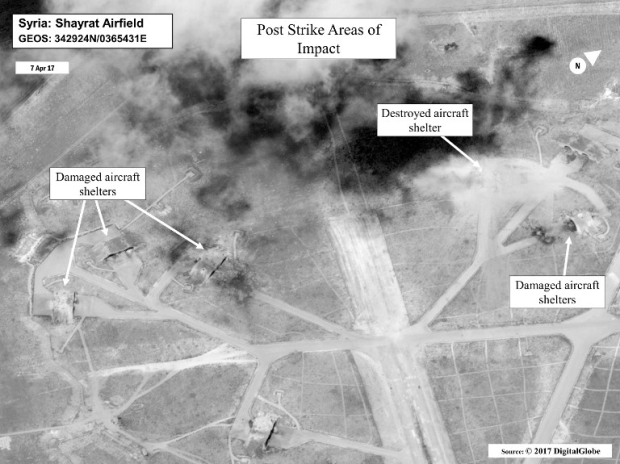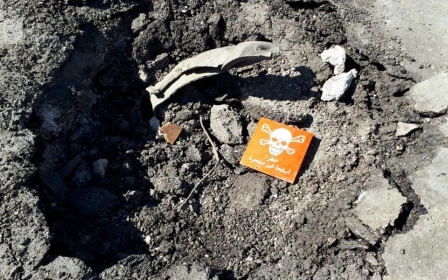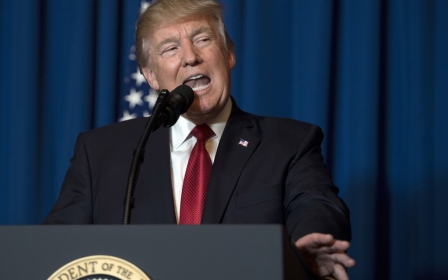Syrian villager: Trump bombed my vegetable patch
US missiles aimed at a Syrian air force base in Homs province caused damage to buildings almost a kilometre from their main target, according to local residents.
Asad al-Khoder, a headteacher living in the village of Shayrat adjacent to the air base of the same name told MEE how the windows of his home were smashed and the ground shook as debris from a missile strike rained down on the front garden where he grows vegetables.
"There was a deafening sound, so loud that it hurt our ears. Outside night turned to day," said Khoder.
He also pointed out a crater about 30 metres from his front door where he believes the base of one of the Tomahawk missiles landed, scattering shrapnel which was subsequently gathered up by local children who handed us fragments to examine.
The statements by Khoder and other residents and officials appear to cast doubt on the accuracy of US accounts which stated that 59 precision-guided missiles had struck the air base and targeted "aircraft, hardened aircraft shelters, petroleum and logistical storage, ammunition supply bunkers, air defence systems, and radars".
US President Donald Trump said after the raid: "We've just fired 59 missiles, all of which hit, by the way, unbelievable, from, you know, hundreds of miles away, all of which hit, amazing."
A Pentagon spokesperson subsequently said that 60 had been fired but that one had landed in water.
Conversations with villagers also suggested that reports by Syria's SANA state news agency that five civilians in the village had been killed may be inaccurate. Local sources told us that nine villagers had been injured in the attack but did not mention any fatalities.
The US launched the raid in response to a nerve gas attack in the town of Khan Sheikhoun in rebel-held Idlib province on 4 April which killed scores of people.
Witnesses told MEE and news agencies that the attack had left bodies scattered across a residential area, killing families as they slept in their beds with many children among the victims. A hospital treating casualties was also subsequently bombed.
Washington said it assessed that the attack had been carried out by "air assets under the command of the Assad regime".
The Syrian government has denied that it was responsible for the attack with President Bashar al-Assad describing it as a "fabrication".
The Organisation for the Prohibition of Chemical Weapons (OPCW), which is responsible for overseeing the decommissioning of Syria's chemical weapons arsenal, is currently conducting an investigation into the attack. The OPCW has previously blamed Assad's government for at least two attacks in 2014 and 2015 involving the use of chlorine.
On Wednesday Ahmet Uzumcu, the head of the OPCW, said that its analysis of biomedical samples collected from victims had provided "incontrovertible" evidence that Sarin or a Sarin-like substance had been used in the attack. Uzumcu said that a fact-finding team was ready to deploy to Khan Sheikhoun if the security situation permitted.
But a draft United Nations Security Council resolution urging the Syrian government to cooperate with the OPCW was vetoed last week by Russia, Assad's main international ally.
'We do not know where they fell'
Talah al-Barazi, the governor of Homs province, told MEE that only 20 US missiles had struck the air base. "But America claimed that 59 missiles hit. We do not know where they fell," he said.
MEE is unable to independently verify Barazi's claim. But Khoder believes he can solve part of that mystery. He said that a section of one missile had fallen in his garden, where he grows tomatoes, potatoes and aubergines.
When the first missile struck at 3.42am, Khoder said he assumed an attack had been launched by the Islamic State (IS) group, which had targeted the village in the past and once held positions just a few kilometres away.
But as the barrage continued for more than two hours, the family concluded that it could only be a US attack. Moussa, Khoder's 14-year-old son, told MEE he had been terrified while the attack was going on.
Another young woman, Lama Zara, told us that she was breastfeeding her eight-month-old son Adnan when the attack began.
She recalled how she held Adnan and his four-year-old sister Hatta under the blanket of her bed as the attack went on until her husband, who had been working a night shift at a local farm, came back to protect them.
"They attacked the air field because the Syrian army was beating al-Qaeda and Daesh [IS]," she said, referring to the fact that the air base had been used to launch air strikes against both IS militants and rebels fighting for and alongside the formerly al-Qaeda-aligned Jabhat Fatah al-Sham.
Khoder said he did not believe that the base had been used to launch the chemical attack and questioned whether the base was being used to store chemical weapons.
'Very clear' responsibility
But chemical weapons experts have told MEE that they believe Syrian government forces were responsible for the attack.
Hamish de Bretton-Gordon, a former commander of the British Joint Chemical, Biological, Radiological and Nuclear (CBRN) Regiment and Nato's Rapid Reaction CBRN Battalion, said it was clear that Damascus had not declared all of its chemical weapon stocks as it had been obliged to do when it signed up to the Chemical Weapons Convention (CWC) in 2013.
"It is very clear to me that the Syrian regime are responsible for the Sarin nerve agents attack on Khan Sheikhun last week. The most likely scenario is that Syrian aircraft dropped a number of bombs filled with the deadly agent which caused the casualties," wrote Bretton-Gordon.
Others have questioned the credibility of the US assessment of the incident pinning the blame on Damascus.
Theodore Postol, a professor at the Massachusetts Institute of Technology and a former scientific adviser at the Pentagon, said he assessed that a nerve agent had been dispersed from a munition placed on the ground citing photographs of the crater used in a White House intelligence assessment.
"The report contains absolutely no evidence that this attack was the result of a munition being dropped from an aircraft. In fact, the report contains absolutely no evidence that would indicate who was the perpetrator of this atrocity,” Postol wrote in a report published on 17 April.
Hans Blix, the former United Nations weapons inspector, wrote on the Oxford Research Group website that on balance it seemed probable that the attack had been carried out by the Syrian government.
Despite being nationals of hostile powers, we were warmly received in Shayrat, with Khoder and his family taking us up to the roof of his small concrete bungalow and serving us tea. Other villagers also invited us into their homes and offered us delicious local almonds.
But Khoder's hospitality did not stop him from directing his anger at US President Donald Trump who he said had betrayed a pre-election pledge to fight IS and al-Qaeda.
"Before the elections the president said that he would fight Daesh [IS] and al-Qaeda. After the election he changed," he said.
"President Trump, he is a crazy man. The great country of America does not deserve such a dumb president."
He also condemned British Prime Minister Theresa May, who expressed support for the US attack.
"She wants to take us back to colonisation, just as it was 100 years ago," he said.
New MEE newsletter: Jerusalem Dispatch
Sign up to get the latest insights and analysis on Israel-Palestine, alongside Turkey Unpacked and other MEE newsletters
Middle East Eye delivers independent and unrivalled coverage and analysis of the Middle East, North Africa and beyond. To learn more about republishing this content and the associated fees, please fill out this form. More about MEE can be found here.






